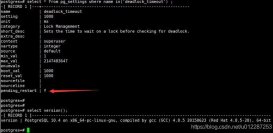創建一個測試表
|
1
2
3
4
5
6
7
8
|
postgres=# create table t1(a int);CREATE TABLEpostgres=# select pg_relation_filepath('t1'); pg_relation_filepath---------------------- base/75062/75297(1 row) postgres=# |
在操作系統上已經可以看到該文件。
|
1
2
|
$ ls -la $PGDATA/base/75062/75297-rw------- 1 postgres postgres 0 Nov 9 11:11 /data/pgdata/11/data/base/75062/75297 |
插入一些數據:
|
1
2
3
4
5
6
7
8
|
postgres=# show segment_size; segment_size-------------- 1GB(1 row)postgres=# insert into t1 select * from generate_series(1,100000000);INSERT 0 100000000postgres=# |
因為segment_size的設置為1GB,磁盤上已經有了多個文件
|
1
2
3
4
5
6
|
$ ls -la $PGDATA/base/75062/75297*-rw------- 1 postgres postgres 1073741824 Nov 9 11:19 /data/pgdata/11/data/base/75062/75297-rw------- 1 postgres postgres 1073741824 Nov 9 11:17 /data/pgdata/11/data/base/75062/75297.1-rw------- 1 postgres postgres 1073741824 Nov 9 11:18 /data/pgdata/11/data/base/75062/75297.2-rw------- 1 postgres postgres 439803904 Nov 9 11:19 /data/pgdata/11/data/base/75062/75297.3-rw------- 1 postgres postgres 917504 Nov 9 11:18 /data/pgdata/11/data/base/75062/75297_fsm |
現在,開啟另一個會話(session 2)。
在session2中,啟動一個事務并創建一個空表,但是不提交事務:
|
1
2
3
4
5
6
7
8
9
10
11
12
13
14
15
16
|
postgres=# begin;BEGINpostgres=# create table t2(a int);CREATE TABLEpostgres=# select pg_relation_filepath('t2'); pg_relation_filepath---------------------- base/75062/75300(1 row) postgres=# select * from pg_backend_pid(); pg_backend_pid---------------- 17710(1 row) postgres=# |
在操作系統已經可以看到對應的文件:
|
1
2
|
$ ls -la $PGDATA/base/75062/75300-rw------- 1 postgres postgres 0 Nov 9 11:23 /data/pgdata/11/data/base/75062/75300 |
如果這個時候,posrgresql server發生了奔潰、或者發生了oom被kill了或者session被kill了。會發生什么呢?
我們來模擬一下session被kill的場景:
|
1
|
$ kill -9 17710 |
再次在session2中執行查詢:
|
1
2
3
4
5
6
|
postgres=# select 1;server closed the connection unexpectedly This probably means the server terminated abnormally before or while processing the request.The connection to the server was lost. Attempting reset: Succeeded.postgres=# |
這個session在事務提交之前被kill了,事務無法正常完成,但是事務已經創建了一個表。應該發生什么呢?事務被回滾,創建的表應該不存在了。
|
1
2
3
4
5
|
postgres=# select * from t2;ERROR: relation "t2" does not existLINE 1: select * from t2; ^postgres=# |
這正是我們所預期的。但在操作系統上,文件仍然存在:
|
1
2
|
$ ls -la $PGDATA/base/75062/75300-rw------- 1 postgres postgres 0 Nov 9 11:23 /data/pgdata/11/data/base/75062/75300 |
這樣,文件就成了孤兒文件(orphaned file)。
postgresql并不知道這個文件屬于哪個relation
|
1
2
3
4
5
|
postgres=# select relname from pg_class where oid = '75300'; relname---------(0 rows) postgres=# |
這樣,你就需要自己手動清理孤兒文件了!
假設你做了大量的數據的加載,就在加載完成之前,會話被殺死:
|
1
2
3
4
5
6
7
8
9
10
11
12
13
14
15
16
17
18
19
20
21
|
postgres=# begin;BEGINpostgres=# create table t3(a int);CREATE TABLEpostgres=# select pg_relation_filepath('t3'); pg_relation_filepath---------------------- base/75062/99528(1 row) postgres=# select * from pg_backend_pid(); pg_backend_pid---------------- 21988(1 row) postgres=# insert into t3 select * from generate_series(1,1000000000);server closed the connection unexpectedly This probably means the server terminated abnormally before or while processing the request.The connection to the server was lost. Attempting reset: Failed. |
雖然會話被kill了。但是磁盤上的空間并沒有被釋放。
|
1
2
3
4
|
$ ls -la $PGDATA/base/75062/99528*-rw------- 1 postgres postgres 1073741824 Nov 9 11:51 /data/pgdata/11/data/base/75062/99528-rw------- 1 postgres postgres 413777920 Nov 9 11:51 /data/pgdata/11/data/base/75062/99528.1-rw------- 1 postgres postgres 385024 Nov 9 11:51 /data/pgdata/11/data/base/75062/99528_fsm |
在最糟糕的時候,可能會占用大量的磁盤空間。那是否有什么方法去檢測這些孤兒文件呢?
你需要比較postgresql中的目錄表中的記錄和文件系統上信息,然后刪除這些孤兒文件。這個過程需要小心謹慎。
首先獲得你要檢測的數據庫的oid:
|
1
2
3
4
5
6
|
postgres=# select oid from pg_database where datname = 'postgres'; oid ------- 75062(1 row) postgres=# |
這樣就可以知道文件在文件系統上的位置。即 $PGDATA/base/[OID_OF_THE_DATABASE]
然后,獲得孤兒文件:
|
1
2
3
4
5
6
7
8
9
10
11
12
|
postgres=# select * from pg_ls_dir ( '/data/pgdata/11/data/base/75062' ) as file where file ~ '^[0-9]*$' and file::text not in (select oid::text from pg_class ); file ------- 75280 75281 75282 75283 75300 83144 99528(7 rows) postgres=# |
補充:理解postgreSQL中的prepared transactions和處理孤兒(orphans)事務

Prepared transactions是PostgreSQL的一個關鍵特性。理解該特性提供的功能和處理任何潛在的陷阱對于系統的維護是很關鍵的。所以,我們來深入研究一下具體什么是prepared transactions。
關于事務
在數據庫系統中,事務是一種處理通常包含多個語句的塊中的全部或零個語句的方法。在提交整個塊之前,該塊中語句的結果對其他事務不可見。 如果事務失敗或回滾,則對數據庫完全沒有影響。
事務依附于會話。但是,當要執行與會話獨立的事務時(也有其他好處)。這就是“prepared transactions”的來源。
prepared transactions
prepared transaction是獨立于會話、抗崩潰、狀態維護的事務。事務的狀態存儲在磁盤上,這使得數據庫服務器即使在從崩潰中重新啟動后也可以恢復事務。在對prepared transaction執行回滾或提交操作之前,將一直維護該事務。
PostgreSQL文檔聲明,在一個已存在的事務塊中,可以使用prepare transaction 'transaction_id‘命令創建一個prepared transaction。它進一步聲明該過程為兩階段提交準備了一個事務。
此外,建議應用程序或交互式會話不要使用prepared transaction。理想情況下,外部事務管理器應該跨同構或異構數據庫資源執行原子的全局事務。
在postgreSQL中,缺省的max_prepared_transaction=0;即關閉了prepared transaction。如果你想使用prepared transaction,建議將max_prepared_transaction設置成max_connections的值。在同步的流復制standby庫上,最好將其設置的比max_connections大一點,以免standby不能接收查詢。
在任何給定的時間,你可以查看活躍狀態的prepared transactions,通過查看視圖pg_prepared_xacts。
pg_prepared_xacts視圖含有以下一些列:
|
1
2
3
4
|
#select * from pg_prepared_xacts; transaction | gid | prepared | owner | database-------------+-----+----------+-------+----------(0 rows) |
1.transaction:事務id
2.gid:用戶為prepared transaction定義的名稱
3.prepared:prepared日期,創建事務時帶有時區的時間戳
4.owner:創建該prepared transaction的事務
5.database:數據庫名
創建prepared transaction
知道什么是prepared transaction之后,現在來看看如何創建一個prepared transaction。創建一個該事務通常需要四個步驟:
1.begin(或start transaction)
2.執行需要的操作
3.prepare transaction
4.commit(或rollback prepared)
prepare transaction、commit prepared、或rollback prepared后面加上一個gid,可以唯一標識prepared transaction。
例如下面的代碼塊:
|
1
2
3
4
5
6
7
8
9
10
11
12
13
14
15
16
17
18
19
20
21
22
|
postgres=# begin;BEGINpostgres=# create table abce(id int);CREATE TABLEpostgres=# insert into abce values(1);INSERT 0 1postgres=# prepare transaction 'abce_insert';PREPARE TRANSACTIONpostgres=# select * from pg_prepared_xacts; transaction | gid | prepared | owner | database-------------+-------------+-------------------------------+----------+---------- 16362 | abce_insert | 2020-12-09 11:41:45.742375+08 | postgres | postgres(1 row) postgres=# commit prepared 'abce_insert';COMMIT PREPAREDpostgres=# select * from pg_prepared_xacts; transaction | gid | prepared | owner | database-------------+-----+----------+-------+----------(0 rows) postgres=# |
當一個含有一個或多個活躍的prepared transactions的postgresql停止了或者奔潰了,會為每個活躍的prepared transaction創建一個文件,在目錄pg_twophase中。
比如,我們有個prepared transaction:
|
1
2
3
4
5
6
7
|
postgres=# select * from pg_prepared_xacts; transaction | gid | prepared | owner | database-------------+--------------+-------------------------------+----------+---------- 16363 | abce_insert2 | 2020-12-09 11:46:01.983483+08 | postgres | postgres(1 row) postgres=# |
所以我沒有提交事務就停止了postgresql server。postgresql就會創建一個名為00003FEB的文件,對應于prepared transaction的事務id。
|
1
2
3
|
$ ls -l ../data/pg_twophase/total 4-rw------- 1 postgres postgres 220 Dec 9 11:47 00003FEB |
00003FEB等價于16363。在postgresql被重啟后,在啟動日志會報如下信息:
|
1
2
3
|
2020-12-09 11:51:28.112 CST [963] LOG: database system was shut down at 2020-12-09 11:47:39 CST2020-12-09 11:51:28.113 CST [963] LOG: recovering prepared transaction 16363 from shared memory2020-12-09 11:51:28.132 CST [960] LOG: database system is ready to accept connections |
如果你不希望恢復一個prepared transaction,可以簡單地刪除pg_twophase文件夾下的相應文件。
這很簡單,不是嗎?那么我們為什么不經常地使用它呢?畢竟,它提供了更高的提交操作成功的可能性。事情要是這么簡單就好了!
prepared transaction可能遇到哪些錯誤?
如果客戶端消失了,則prepared transaction可以未完成(既不提交也不回滾)。發生這種情況的原因多種多樣,包括客戶機崩潰,或者服務器崩潰導致客戶機連接被終止而無法重新連接。你實際上是依靠事務管理器來確保沒有孤立的prepared transaction。
除了崩潰之外,還有另一種原因可以使prepared transaction未完成。如果一個用于恢復的備份包含了事務的prepared階段,但是沒有包含關閉事務的階段,仍然會生成孤兒事務。
或者,DBA創建了一個prepared transaction,卻忘記了關閉它。
所以,如果一個prepared transaction沒有完成,又會有什么大不了的呢?
真正的問題
真正的問題是,孤兒prepared transaction繼續持有可能包含鎖的關鍵系統資源,或者使事務ID保持活動狀態,該事務ID可能會阻止vacuum清除只對該孤兒事務可見、對其它事務不可見的死的元組。
回想一下我在上面創建的prepared 事務。當事務prepared,并且在提交該事務之前,如果另一個事務試圖更改該表,它將無法獲取所需的鎖并掛起,直到解決了prepared事務(提交或回滾)為止。 否則,alter命令會無限期掛起,最終,我必須發出CTRL + C來停止該命令。
|
1
2
3
4
5
6
7
8
9
10
11
12
13
14
15
16
17
18
19
|
postgres=# select * from pg_prepared_xacts; transaction | gid | prepared | owner | database-------------+--------------+-------------------------------+----------+---------- 16363 | abce_insert2 | 2020-12-09 11:46:01.983483+08 | postgres | postgres(1 row) postgres=# alter table abce add column b int;^CCancel request sentERROR: canceling statement due to user requestpostgres=# select c.oid,c.relname,l.locktype,l.relation,l.modepostgres-# from pg_class cpostgres-# inner join pg_locks l on c.oid=l.relationpostgres-# where c.relname='abce'; oid | relname | locktype | relation | mode --------+---------+----------+----------+------------------ 370883 | abce | relation | 370883 | RowExclusiveLock(1 row) postgres=# |
對vacuum的阻塞可能會更嚴重,在極端情況下,會導致數據庫關閉,因為孤兒prepared事務會阻止事務id的wrap around。
發現和通知
雖然一般的預期是prepared事務在幾秒鐘內完成,但是情況并不總是這樣。一個prepared事務可能持續幾分鐘、幾小時甚至幾天。
為這些事務維護元數據本身可能是一項挑戰。但是,我建議設置一個術語來定義prepared事務可以存在的最大時間。例如,考慮以下的prepared事務:
|
1
2
3
4
5
6
|
postgres=# BEGIN;BEGINpostgres=# INSERT INTO abce VALUES(3);INSERT 0 1postgres=# PREPARE TRANSACTION 'abce_insert 1m';PREPARE TRANSACTION |
或者下面的事務:
|
1
2
3
4
5
6
|
postgres=# BEGIN;BEGINpostgres=# INSERT INTO abce VALUES(4);INSERT 0 1postgres=# PREPARE TRANSACTION 'abce_insert 1d';PREPARE TRANSACTION |
在這些事務名稱中,最后一部分定義事務的時間。任何超出時間的事務可以通過sql查詢輕易地找出來:
|
1
2
3
4
5
6
7
8
9
|
postgres=# select gid,prepared,regexp_replace(gid, '.* ', '') AS agefrom pg_prepared_xactsWHERE prepared + CAST(regexp_replace(gid, '.* ', '') AS INTERVAL) < NOW(); gid | prepared | age----------------+-------------------------------+----- abce_insert 1m | 2020-12-09 13:39:01.383091+08 | 1m(1 row) postgres=# |
這里就很清晰地顯示了一個不應該再有效的事務。因此,使用一個外部代理或者cron任務可以輕易找出這些事務,或者通知管理員、或者回滾事務。
在我看來,這是一種簡單而容易的方式,可以確保即使事務管理器失敗或DBA意外地留下了一個事務,也可以在你的環境中管理孤兒事務。
結論
Prepared transactions顯然是一個非常重要的功能,但是需要使用回退通知程序或清理程序仔細設置環境,以輕松確保這些事務不會不必要地占用關鍵資源,并且系統保持良好狀態。
PostgreSQL社區中仍在討論如何處理孤兒prepared事務。它是否成為postgresql核心的一部分尚待觀察。同時,我們需要使用外部工具來管理這些事務,或者設法解決這個問題。
以上為個人經驗,希望能給大家一個參考,也希望大家多多支持服務器之家。如有錯誤或未考慮完全的地方,望不吝賜教。
原文鏈接:https://www.cnblogs.com/abclife/p/13948101.html















